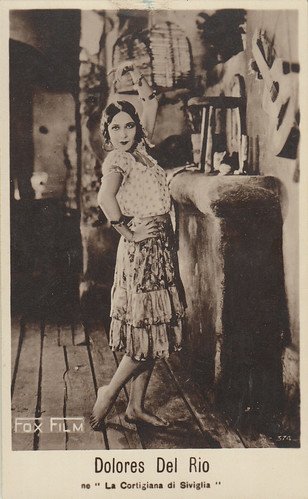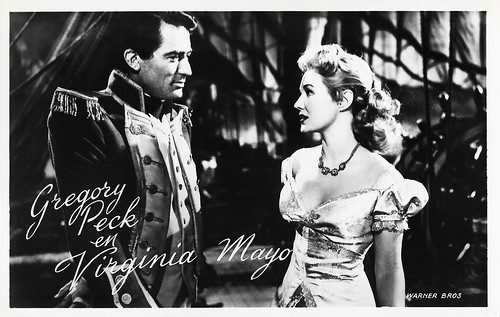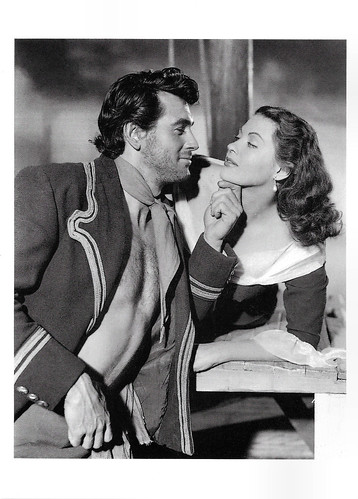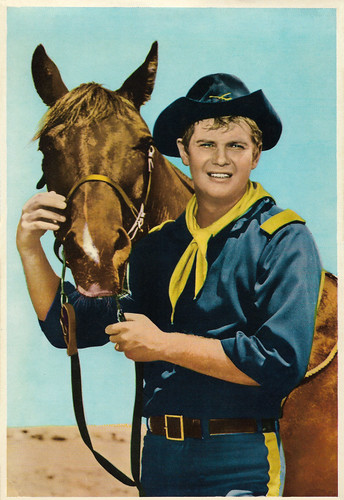
German postcard by Ross Verlag, no. 3097/1. Photo: United Artists. Gloria Swanson and Raoul Walsh in Sadie Thompson (Raoul Walsh, 1928).

German postcard by Ross Verlag, Berlin, no. 40/3. Photo: IFA / United Artists. Douglas Fairbanks in The Thief of Bagdad (Raoul Walsh, 1924).

German postcard by Ross Verlag, no. 4490/2, 1929-1930. Photo: Fox. Dolores del Río in The Loves of Carmen (Raoul Walsh, 1927).
The younger version of Pancho Villa
Raoul Walsh was born Albert Edward Walsh in 1887 in New York. His parents were Elizabeth T. Bruff, the daughter of Irish Catholic immigrants, and Thomas W. Walsh, an Irish revolutionary turned successful tailor who designed the uniforms for Theodore Roosevelt’s Rough Riders. One of his three brothers was silent cinema actor George Walsh. He attended Seton Hall College, New Jersey, but after his mother died in 1903, Albert ran away from home. He was 15 years old and sailed to Cuba on a trading ship belonging to his uncle. In the following years, he got by doing various jobs such as undertaker, surgeon's assistant, rodeo rider and cowboy. His acting career began in 1907 when he performed onstage in San Antonio. In 1909, Walsh started to work in the theatre in New York, where he took the name Raoul.
His adventurous spirit and creative energy led him to the film industry, and by 190,9 he was playing cowboy roles in silent films for the Pathé Studio in New Jersey. Around 1913, Walsh was working as an actor and assistant director for David Wark Griffith at Biograph in Hollywood. Griffith also gave him his first opportunity as a (second unit) director when he and Christy Cabanne shot one of the first feature-length films, The Life of General Villa (Christy Cabanne, Raoul Walsh, 1914), starring Mexican bandit-turned-revolutionary Pancho Villa as himself and Walsh as the younger version of Villa. The film incorporated both staged scenes and authentic live footage from real battles during the Mexican Revolution, around which the plot of the film revolves. The following year, Walsh played John Wilkes Booth, the man who assassinated President Abraham Lincoln at Ford's Theater in Washington, in Griffith's classic The Birth of a Nation (D.W. Griffith, 1915) and also served as an assistant director and editor. He worked with Griffith for 20th Century Fox until 1928.
In 1915, in addition to helping out the great Griffith, Walsh directed no less than 14 films. He caused a sensation with the crime feature film The Regeneration (Raoul Walsh, 1915), starring Rockliffe Fellowes and Anna Q. Nilsson. He filmed the innovative gangster film on location in the Bowery on the Lower East Side of Manhattan, and it was based on the autobiography of Owen Frawley Kildare, 'the Kipling of the Bowery'. Walsh served as an officer in the United States Army during World War I. For the next decade, Walsh continued to direct several films each year. One of his most acclaimed silents, The Honor System (Raoul Walsh, 1917), about a man falsely imprisoned under brutal conditions, was at the time considered by some, including director John Ford, to be even better than The Birth of a Nation. However, the film is considered lost. By the mid-1920s, Walsh had developed a straightforward, no-frills style which was particularly suited to adventure films. One of Walsh's best-known silent films is the fantasy The Thief of Bagdad (Raoul Walsh, 1924) with Douglas Fairbanks. Adapted from 'One Thousand and One Nights', the film tells the story of a thief who falls in love with the daughter of the Caliph of Baghdad. Lavishly staged on a Hollywood studio set, at a reputed cost of $1,135,654.65, The Thief of Bagdad was one of the most expensive films of the 1920s.
One of his greatest financial successes was the war comedy What Price Glory? (Raoul Walsh, 1926), starring Victor McLaglen, Edmund Lowe and Dolores del Río. Fox first released it in the US as a silent film on 23 November 1926 and re-released the film in January 1927 with synchronised sound effects and music in the Movietone system. He made the first version of W. Somerset Maugham's 'Rain', renamed Sadie Thompson (Raoul Walsh, 1928), starring Gloria Swanson as a prostitute seeking a new life in Samoa. Walsh also starred as Swanson's boyfriend in his first acting role since 1915. He was then hired to direct and star in In Old Arizona, a film about O. Henry's character, the Cisco Kid. While on location for that film, Walsh was in a car crash when a jackrabbit jumped through the windshield as he was driving through the desert. Walsh lost his right eye as a result and would wear an eyepatch for the rest of his life. Irving Cummings finished directing the film (and earned an Oscar nomination for it). Walsh also gave up the part of the Cisco Kid and never acted again. Warner Baxter filled the role and also won an Oscar.
Raoul Walsh made a smooth transition to sound film. Walsh’s first talkie was The Cock-Eyed World (Raoul Walsh, 1929), the popular sequel to What Price Glory?, with McLaglen and Lowe’s marines now frolicking in Russia, Brooklyn, and South America. He directed the first widescreen spectacle, the Western The Big Trail (Raoul Walsh, 1930), in which he gave the then-unknown John Wayne his first leading role as the head of a wagon train on the Oregon Trail. Raoul Walsh had discovered the 23-year-old as a prop man named Marion Morrison. At the time, Walsh happened to be reading a book about the Revolutionary War general Mad Anthony Wayne and Morrison was renamed after him. The Western was not successful at the box office at the time, but later gained greater recognition. Walsh directed the comedy The Bowery (Raoul Walsh, 1933), starring Wallace Beery and George Raft as rival saloon owners in 1890s New York City. The film recounts the story of Steve Brodie (Raft), supposedly the first man to jump off the Brooklyn Bridge and live to brag about it.

Italian postcard by Le grandi Films, Verginio Rebua, Milano, 81. Photo: Goldwyn Pictures. Possibly Antonio Moreno in Lost and Found on a South Sea Island (Raoul Walsh, 1923).

German postcard by Ross Verlag, Berlin, no. 40/1. Photo: IFA / United Artists. Douglas Fairbanks in The Thief of Bagdad (Raoul Walsh, 1924).

Austrian postcard by Iris Verlag, no. 358/3. Photo: Paramount Film. Greta Nissen in The Wanderer (Raoul Walsh, 1925).

Belgian postcard by Weekblad 'Cinema', Antwerpen. Victor McLaglen in What Price Glory? (Raoul Walsh, 1926).

French postcard by A.N., Paris, no. 331. Photo: Max Munn Autrey / Fox Film. Dolores Del Rio and Edmund Lowe in What Price Glory? (Raoul Walsh, 1926).

Italian postcard by G.B. Falci Editore, Milano, no. 374. Photo: Fox Film. Dolores Del Rio in The Loves of Carmen (Raoul Walsh, 1927). Collection: Marlene Pilaete.

German postcard by Ross Verlag, no. 3905/3, 1928-1929. Photo: Fox. Dolores Del Rio in The Red Dance (Raoul Walsh, 1928). Del Rio is wearing a kokoshnik (Russian: коко́шник; IPA: [kɐˈkoʂnʲɪk]), a traditional Russian head-dress worn by women and girls.
From Fox to Paramount to Warner Bros
Until the mid-1930s, Raoul Walsh worked at William Fox's Fox Studios. Then he moved to Paramount, where he worked from 1935 to 1939. After this undistinguished period, Walsh's career rose to new heights when he moved to Warner Bros. The Roaring Twenties (Raoul Walsh, 1939), starring James Cagney and Humphrey Bogart, was the first of a series of classic gangster films he directed for Warner. Michael Barson at Britannica: "Walsh turned out a crisp mini-epic spanning 15 years in the life of a gangster (James Cagney at the top of his form) who is forced into racketeering to survive after World War I and then develops a taste for it." His other gangster films were High Sierra (Raoul Walsh, 1941) starring Ida Lupino and Humphrey Bogart, and White Heat (Raoul Walsh, 1949) starring James Cagney and Edmond O'Brien. Michael Barson: "With High Sierra (1941), Walsh enjoyed a breakthrough, as did star Bogart, who had the lucky chance of both Paul Muni and (George) Raft turning down the part of Mad Dog Earle, a sensitive robber sprung from prison to pull off a big heist. High Sierra is considered a classic, thanks in part to the script by John Huston, the spectacular location photography of the Sierra Nevada mountains, and the fine supporting performance of Lupino as Marie, a dance-hall girl who truly understands Earle. "
Walsh also worked with Errol Flynn on several films in the 1940s after Flynn had fallen out with his previously preferred director, Michael Curtiz. Walsh directed him as General Custer in the Western War film They Died with Their Boots On (Raoul Walsh, 1941), the eighth and last joint appearance of screen couple Errol Flynn and Olivia de Havilland. The film was one of the top-grossing films of 1941. Walsh and Flynn teamed up twice in 1942. Desperate Journey (Raoul Walsh, 1942) was a tale of five Allied pilots (including Ronald Reagan) who are shot down over Germany and try to make their way back to England. Gentleman Jim (Raoul Walsh, 1942) was a biopic of boxing champ Jim Corbett. Objective, Burma! (Raoul Walsh, 1945), It was an excellent and gritty War film, with Flynn starring in one of his finest performances as the leader of 50 paratroopers trapped behind Japanese lines in the jungle. Walsh was originally slated to direct Adventures of Don Juan (Vincent Sherman, 1948), but in 1945, Flynn had a falling-out with Walsh, too.
At Republic Pictures, he directed John Wayne and Roy Rogers in Dark Command (Raoul Walsh, 1940). His successes at Warner also included They Drive By Night (1940), with George Raft, Ann Sheridan, Ida Lupino and Humphrey Bogart, the romantic comedy The Strawberry Blonde (1941), with James Cagney and Olivia de Havilland, and Manpower (1941), with Edward G. Robinson, Marlene Dietrich and George Raft. Pursued (Raoul Walsh, 1947) was his first Western in many years, and it was a good one, with Robert Mitchum as an orphan haunted by disturbing dreams about his family’s murder. White Heat (1949) showed Walsh once more at the peak of his powers. Michael Barson: "James Cagney had one of his greatest roles as Cody Jarrett, a psychopathic yet pathetically tortured killer. Walsh eschewed the conventions of the then-popular film noir to make this an homage to Warner Brothers’s crime pictures of the early 1930s." Walsh had one of his biggest hits with Captain Horatio Hornblower R.N. (1951), a well-mounted version of the C.S. Forester novels, which starred Gregory Peck as the British naval commander who conquers all during the Napoleonic Wars.
Raoul Walsh's contract at Warner expired in 1953, but he directed several films afterwards. The Lawless Breed (Raoul Walsh, 1953) had Rock Hudson in an early starring role as legendary gunman John Wesley Hardin, but Sea Devils (Raoul Walsh, 1953), filmed in England, used Hudson less well as a Channel Islands smuggler in about 1800 who gets mixed up with a spy (Yvonne De Carlo). Walsh revitalised Clark Gable's stagnating career and helped the actor reach the top ten box office stars for the last time with the Western The Tall Men (Raoul Walsh, 1955), with Jane Russell, Robert Ryan and Cameron Mitchell. Walsh directed Gable also in The King and Four Queens (Raoul Walsh, 1956) and Band of Angels (Raoul Walsh, 1957). He directed his last film in 1964, the Western A Distant Trumpet (Raoul Walsh, 1964) with Troy Donahue. Peter Bogdanovich, who interviewed Walsh for his book 'Who the Devil Made It', called the film "One of Walsh's weakest pictures, caused mainly by an intolerably bad cast and a predictable script. Whenever the director is allowed to linger on shots of horses and riders, Indians and cavalry, and on their battles, he shows his vitality, personality and strength. Otherwise, his efforts are hopeless against the talentless players and the hopeless words they are required to speak."
As a writer, his last script was made in 1970, meaning his career as a whole spanned seven decades and 58 years. He also wrote his autobiography, 'Each Man In His Time' (1974). Walsh suffered from physical difficulties, primarily fading sight in his one good eye. Raoul Walsh died of a heart attack in 1980, in Simi Valley, California, at the age of 93. He was interred at the Assumption Catholic Cemetery, Simi Valley, California. Walsh was married three times, but was a ladies' man and had many extramarital affairs. He disliked his first wife, actress Miriam Cooper, intensely and referred to her in his autobiography as the "mercenary witch." As both were Catholics, Cooper never remarried after their divorce. They had two adopted sons. From 1928 to 1947, he was married to actress Lorraine Miller and from 1947 till his death to Mary Simpson. Raoul Walsh was one of the 36 founders of the Academy of Motion Picture Arts and Sciences (AMPAS). Surprisingly, he never won an Oscar, nor was he recognised by the Academy with a lifetime achievement award. At Hollywood's Golden Age, Chris Whiteley describes Walsh as "one of the most neglected major figures in the development of Hollywood cinema". His work has been noted as an influence on directors such as Rainer Werner Fassbinder, Jack Hill, and Martin Scorsese.

British postcard by Film Weekly. Photo: 20th Century / United Artists. Wallace Beery and Jackie Cooper in The Bowery (Raoul Walsh, 1933).

West German postcard by Kolibri-Verlag, no. 514. Photo: Warner Bros. Errol Flynn in San Antonio (David Butler, Robert Florey, Raoul Walsh, 1945).

Dutch postcard by Takken, Utrecht, no. 610. Photo: Warner Bros. Gregory Peck and Virginia Mayo in Captain Horatio Hornblower (Raoul Walsh, 1951).

British postcard in the Picturegoer Series, London, no. D. 213. Photo: Universal International. Anthony Quinn and Ann Blyth in The World in His Arms (Raoul Walsh, 1952).

Swiss-German-British postcard by News Productions, Baulmes / Filmwelt Berlin, Bakede / News Productions, Stroud, no. 56493. Rock Hudson and Yvonne De Carlo in Sea Devils (Raoul Walsh, 1952), produced by Coronado (RKO).

German postcard by Kolibri-Verlag, Minden/Westf., no. 1631. Photo: Columbia. Donna Reed and Rock Hudson in Gun Fury (Raoul Walsh, 1953).

Spanish postcard by Archivo Bermejo, no. C- 245. Photo: Warner Bros. Troy Donahue in A Distant Trumpet (Raoul Walsh, 1964).
Sources: Michael Barson (Britannica), Chris Whiteley (Hollywood's Golden Age), Jon C. Hopwood (IMDb), Wikipedia (Dutch, German and English) and IMDb.
No comments:
Post a Comment